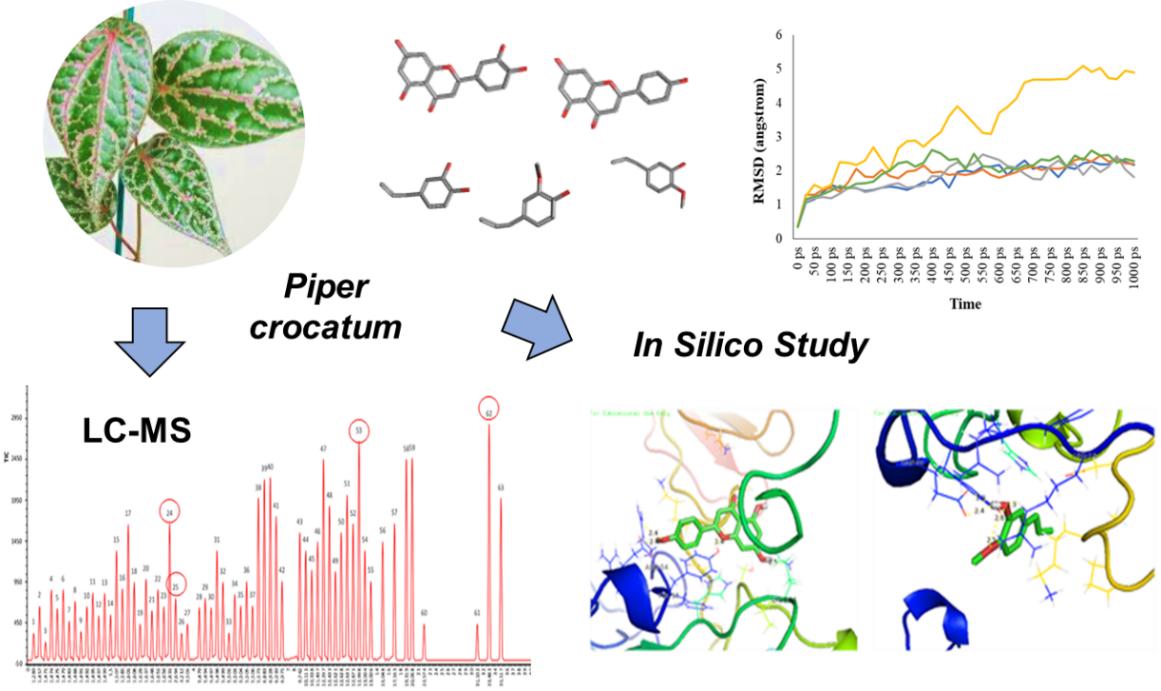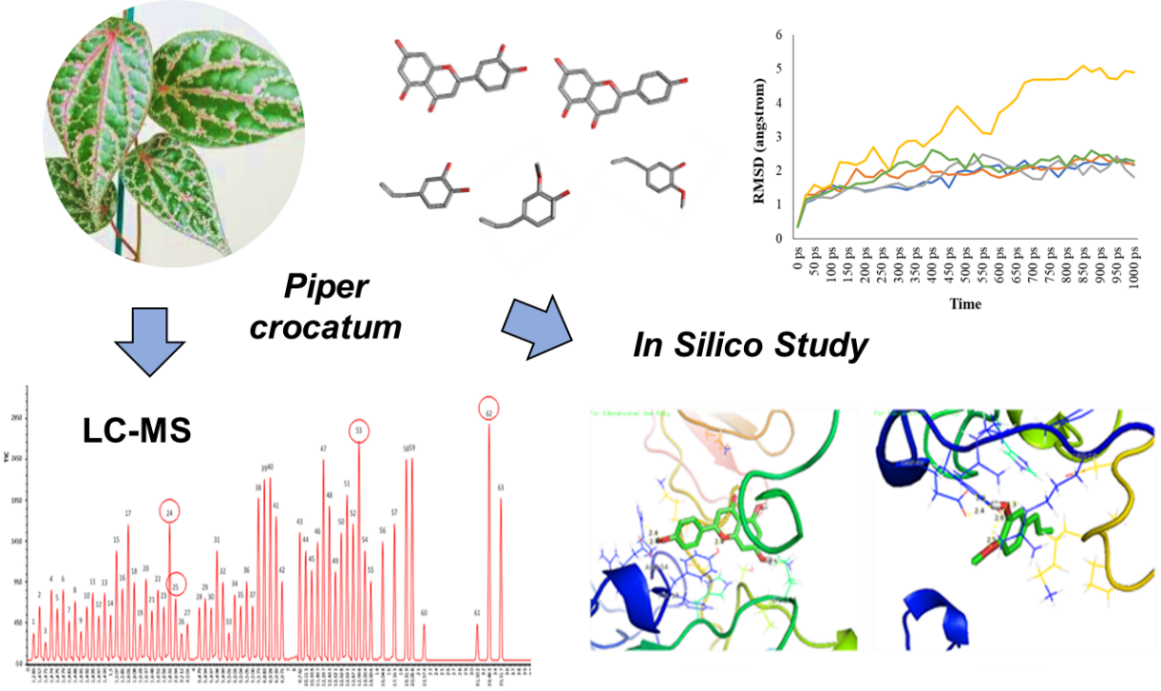Molecular Dynamics Simulation of Various Bioactive Compounds of Red Betel (Piper crocatum) as Anti-Inflammatory Drug-Like Candidates in Rheumatoid Arthritis Treatment
DOI:
https://doi.org/10.48048/tis.2024.7334Keywords:
Apigenin, In Silico, Natural compounds, Red betel, Rheumatoid arthritisAbstract
Joint inflammation and damage can be caused by rheumatoid arthritis (RA), a systemic autoimmune disorder. Long-term RA affects the joints, causing pain, edema, and stiffness. Several studies have revealed that the exact origin of RA is still unidentified, but inherited disorder and external factors may contribute to the inflammatory condition. The incidence of RA is mostly caused by uncontrolled-production of pro-inflammatory cytokines under nuclear factor-kappa B (NF-κB) overexpression condition. The nuclear factor-kappa B plays an important role in inflammatory T cell activation, differentiation, and effector function. Therefore, the inhibition of NF-κB can be a strategy to reduce the adverse effects or incidence of RA. Red betel is a perennial herb native to Indonesia that is widely used by conventional healers. Many reports show that red betel leaf extracts contain several critical bioactive compounds such as Apigenin, Luteolin, Hydroxychavicol, Eugenol, and Chavibetol. This present study aims to evaluate and predict the therapeutic potential of those compounds as medication that reduce inflammation against RA by disturbing and inactivating the NF-κB molecular interaction. The LC-MS chromatography was used to evaluate the chemical contents of red betel leaves. Furthermore, in silico study, the 3D structure of the active compounds of red betel leaves is obtained from PubChem web server, while NF-κB is obtained from Protein Data Bank (PDB) website. Molecular docking was used to screen the potential compounds compared to aspirin as control. As a result, 2 compounds including Apigenin and Luteolin have smaller bond affinity values, −6.3 and −6.0 kcal/mol, respectively compared to aspirin. Based on molecular dynamics (MD) simulation, the root-mean-square deviation (RMSD) value of protein-ligand complexes have the similar pattern over 1000/ps except the NF-κB-Chavibetol complex which has an unstable pattern. On the other hand, the total energy of the protein-ligand complexes have similar average number of −1.69 kJ/mol. The simulation indicates the ligands have constant binding energy to the protein. Furthermore, numerous pharmacokinetic properties of compounds including absorption, distribution, metabolism, excretion and toxicity are exponentially greater than the control drugs. Finally, red betel active compounds can be used as alternative candidates of RA therapy medication.
HIGHLIGHTS
- Rheumatoid arthritis, a systemic autoimmune condition, damages joints. Long-term RA causes joint discomfort, swelling, and stiffness.
- The identified flavonoids from red betel leaf extract include flavonone, isoflavone, auron, catechin, anthocyanidin, and chalcone.
- Apigenin, chavibetol, eugenol, hydroxychavicol, and luteolin, the active chemicals found in red betel, have the potential to serve as NF-B inhibitors, making them potentially useful in the treatment of rheumatoid arthritis.
GRAPHICAL ABSTRACT

Downloads
Metrics
References
M Tsubaki, T Takeda, T Kino, T Itoh, M Imano, G Tanabe, O Muraoka, T Satou and S Nishida. Mangiferin suppresses CIA by suppressing the expression of TNF-α, IL-6, IL-1β, and RANKL through inhibiting the activation of NF-κB and ERK1/2. Am. J. Translational Res. 2015; 7, 1371-81.
Y Okada, D Wu, G Trynka, T Raj, C Terao, K Ikari, Y Kochi, K Ohmura, A Suzuki and S Yoshida. Genetics of rheumatoid arthritis contributes to biology and drug discovery. Nature 2014; 506, 376-81.
I Rudan, S Sidhu, A Papana, SJ Meng, YX Wei, W Wang, RMC Page, AR Demaio, H Nair and D Sridhar. Prevalence of rheumatoid arthritis in low–and middle–income countries: A systematic review and analysis. J. Global Health 2015; 5, 010409.
JS Smolen, D Aletaha and IB McInners. Rheumatoid arthritis. Lancet 2016; 388, 2023-38.
A Oeckinghaus and S Ghosh. The NF-κB family of transcription factors and its regulation. Cold Spring Harbor Perspect. Biol. 2009; 1, a000034.
T Liu, L Zhang, D Joo and SC Sun. NF-κB signaling in inflammation. Signal Transduct. Targeted Ther. 2017; 2, 17023.
A Salminen, M Lehtonen, T Suuronen, K Kaarniranta and J Huuskonen. Terpenoids: Natural inhibitors of NF-κB signaling with anti-inflammatory and anticancer potential. Cell. Mol. Life Sci. 2008; 65, 2979-99.
INE Lister, RD Viany, AN Nasution, R Zein, Y Manjang and E Munaf. Antimicrobial activities of methanol extract of Sirih Merah (Piper crocatum L.) leaf. J. Chem. Pharmaceut. Res. 2014; 6, 650-4.
MJW Chang, CY Ko, RF Lin and LL Hsieh. Biological monitoring of environment exposure to safrole and the Taiwanese betel quid chewing. Arch. Environ. Contam. Toxicol. 2002; 43, 432-7.
SR Gundala and R Aneja. Piper betel leaf: A reservoir of potential xenohormetic nutraceuticals with cancer-fighting properties. Canc. Prev. Res. 2014; 7, 477-86.
SI Maslikah, SR Lestari and N Wulandari. Active compounds of red betel (Piper crocatum) extract for safe antioxidant as cytotoxicity test revealed. Int. J. ChemTech Res. 2016; 9, 513-20.
SI Maslikah, SR Lestari, N Handayani, WE Putra, ARN Alimah, A Amalia, S Afifah and SN Arifah. The anti-inflammatory potential of red betel (Piper crocatum) leaves through inhibitory mechanism on NFκB signaling pathway: Drug-like candidate study. Nat. Life Sci. Comm. 2023; 22, 1-19.
M Safithri, A Kurniawati and S Suminto. Formula of Piper crocatum, Cinnamomum burmanii, and Zingiber officinale extracts as a functional beverage for diabetics. Int. Food Res. J. 2016; 23, 1123-30.
WE Putra, WO Salma and M Rifa’i. Anti-inflammatory activity of sambucus plant bioactive compounds against TNF-α and TRAIL as solution to overcome inflammation associated diseases: The insight from bioinformatics study. Nat. Prod. Sci. 2019; 25, 215-21.
WE Putra. In silico study demonstrates multiple bioactive compounds of sambucus plant promote death cell signaling pathway via fas receptor. FUW Trends Sci. Tech. J. 2018; 3, 682-5.
A Hidayatullah, WE Putra, Sustiprijatno, D Widiastuti, WO Salma and MF Heikal. Molecular docking and molecular dynamics simulation-based identification of natural inhibitors against druggable human papilloma virus type 16 target. Trends Sci. 2023; 20, 4891.
A Hidayatullah, WE Putra, M Rifa’i, Sustiprijatno, D Widiastuti, MF Heikal, H Susanto and WO Salma. Molecular docking and dynamics simulation studies to predict multiple medicinal plants’ bioactive compounds interaction and its behavior on the surface of DENV-2 E protein. Karbala Int. J. Mod. Sci. 2022; 8, 531-42.
I Jutooru, G Chadalapaka, P Lei and S Safe. Inhibition of NF-κB and pancreatic cancer cell and tumor growth by curcumin is dependent on specificity protein down-regulation. J. Biol. Chem. 2010; 285, 25332-44.
H Meduru, YT Wang, JJ Tsai and YC Chen. Finding a potential dipeptidyl peptidase-4 (DPP-4) inhibitor for type-2 diabetes treatment based on molecular docking, pharmacophore generation, and molecular dynamics simulation. Int. J. Mol. Sci. 2016; 17, 920.
A Kumar and U Bora. In silico inhibition studies of NF-kB p50 subunit by curcumin and its natural derivatives. Med. Chem. Res. 2012; 21, 3281-7.
DEV Pires, TL Blundell and DB Ascher. pkCSM: Predicting small-molecule pharmacokinetic and toxicity properties using graph-based signatures. J. Med. Chem. 2015; 58, 4066-72.
TS Carpenter, DA Kirshner, EY Lau, SE Wong, JP Nilmeier and FC Lightstone. A method to predict blood-brain barrier permeability of drug-like compounds using molecular dynamics simulations. Biophys. J. 2014; 107, 630-41.
JK Yano, MR Wester, GA Schoch, KJ Griffin, CD Stout and EF Johnson. The structure of human microsomal cytochrome P450 3A4 determined by x-ray crystallography to 2.05-Å resolution. J. Biol. Chem. 2004; 279, 38091-4.
PH Marathe. Pharmacokinetic considerations in drug design and development. ACS Webinars. Washington DC, 2015.
R Pramely and TLS Raj. Prediction of biological activity spectra of a few phytoconstituents of Azadirachta indica A. Juss. J. Biochem. Tech. 2012; 3, 375-9.
P Arulselvan, MT Fard, WS Tan, S Gothai, S Fakurazi, ME Norhaizan and SS Kumar. Role of antioxidants and natural products in inflammation. Oxidative Med. Cell. Longevity 2016; 2016, 5276130.
FA Sinaga. Stress oksidatif dan status antioksidan pada aktivitas fisik maksimal (oxidative stress and antioxidant status at maximal physical activity). Jurnal Generasi Kampus 2016; 9, 176-89.

Downloads
Published
How to Cite
Issue
Section
License
Copyright (c) 2023 Walailak University

This work is licensed under a Creative Commons Attribution-NonCommercial-NoDerivatives 4.0 International License.






